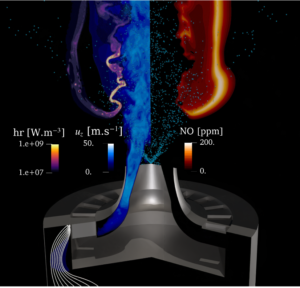🎓Thomas NAESS thesis defense
Thursday 31 October 2024From 14h00 at 16h00
Phd Thesis JCA ROOM, CERFACS, TOULOUSE, FRANCE
Numerical prediction of nitric oxide formation in turbulent spray flames using Large Eddy Simulation

https://youtube.com/live/PPNwManD3vs?feature=share
The 21st century is marked by an unprecedented usage of fossil fuels directly contributing to climate change. Their combustion intrinsically releases greenhouse gas concentrations and induces air pollution. Notably, the adverse impacts on both human health and the environment caused by nitrogen oxides (NOx), with nitric oxide (NO) primarily formed, have led to stringent regulations. Therefore, enhancing
combustion efficiency and reducing related pollutant emissions are interesting short-to medium-term levers. Substantial improvements in computational capacity havemade Large Eddy Simulation (LES) of turbulent spray flames affordable, even with multiple additional transported species. Thus, NOx prediction within this frame-work is promising for understanding pollutant formation processes and providing quantitative predictions for designing future low-NOx aeronautical engines.
In this context, numerical prediction of NOx relies on accurate kinetic models describing fuel oxidation and nitrogen chemistry. On the first hand, significant variability in NOx prediction is observed among comprehensive mechanisms, compared to recent measurements. While NOx are qualitatively known for decades, uncertainties persist and their quantitative description in complex fuels remains a challenge. On the other hand, detailed mechanisms encompass a prohibitive number of species for LES application. Therefore, two NOx prediction approaches are evaluated and compared: Analytically Reduced Chemistry (ARC) and hybrid Globally Reduced Chemistry (GRC)/tabulated prediction – named NOMAGT -, both
combined with Thickened Flame model for LES (TFLES). ARCs describing both hydrocarbon oxidation and NOx chemistry are derivated and thoroughly validated for n-heptane and n-decane fuels. The new mechanisms have proven good accuracy in canonical laminar flames confirming the reduction methodology. Then, derivated chemistries are employed in turbulent configurations within the LES framework to evaluate their predictability. First, the academic Coria Rouen Spray Burner (CRSB) featuring unpreceded in-flame NO measurements is emulated with highly resolved simulation and ARC. Even though flame properties exhibit satisfactory predictions, quantitative discrepancies in NO are evidenced, albeit qualitatively similar. The results demonstrated the importance of radiation in such flames and NO kinetics, albeit to a smaller extent. Then, the methodology is applied to the 4si aeronautical combustion chamber with ARC's prediction standing as the reference case. The NOMANI/GRC/TFLES (NOMAGT) strategy has therefore been derived to predict ARC's NOx levels and is thoroughly compared. The results have demonstrated the capability of NOMAGT to predict satisfactory levels of NO at substantially lower cost.
Jury
| Ronan Vicquelin | EM2C | Reviewer |
| Alessandro Stagni | Politecnico di Milano | Reviewer |
| Nathalie Lamoureux | PC2A | Examiner |
| Frédéric Grisch | CORIA | Examiner |
| Bénédicte Cuenot | Safran Aircraft Engines | Examiner |
| Jean-Christophe Jouhaud | CERFACS | Supervisor |
| Stéphane Richard | Safran Helicopter Engines | Invited |
| Éléonore Riber | CERFACS | Invited |
No content defined in the sidebar.

